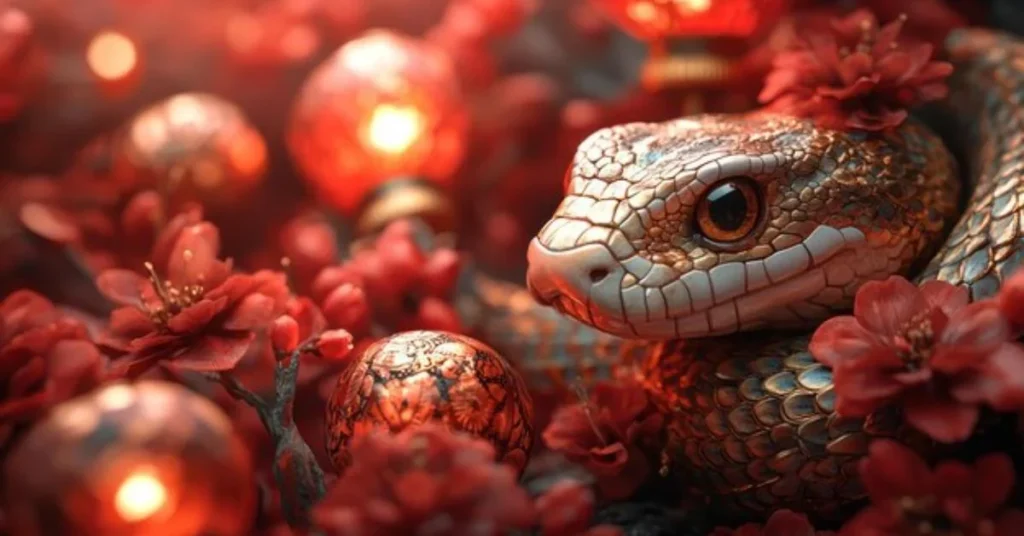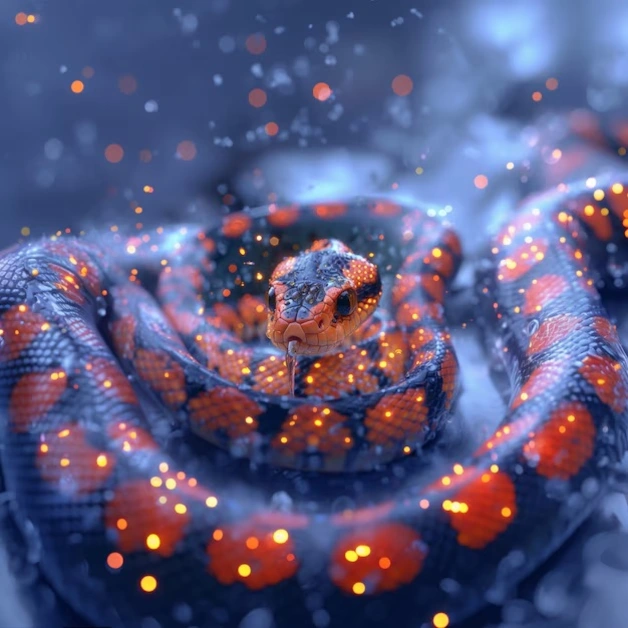The term “ruby snake” carries a sense of allure and mystery, intertwining the worlds of nature, mythology, and culture. Its vivid imagery evokes associations with passion, transformation, and vitality. From the stunning ruby-eyed pit viper to the unique ruby morph of the corn snake, and even the symbolic meanings of snakes adorned with ruby hues, the concept of the ruby snake resonates across multiple dimensions. This article explores its natural, cultural, and symbolic significance while addressing the broader connections to mythology and conservation.
The Ruby Snake in Nature
When discussing the ruby snake, two notable references arise in the natural world: the ruby-eyed pit viper, a relatively recent discovery, and the ruby corn snake, a prized morph among reptile enthusiasts.
The Ruby-Eyed Pit Viper: Nature’s Gem
Discovered in the lush forests of Southeast Asia in 2011, the ruby-eyed pit viper quickly garnered attention due to its extraordinary appearance. Its eyes, glimmering like polished rubies, give the snake a jewel-like allure. Found in remote forested areas, this species exemplifies the rich biodiversity of Southeast Asia, a region renowned for its diverse flora and fauna.
Physical Features and Behavior
The ruby-eyed pit viper is a medium-sized snake with a vibrant green body that provides excellent camouflage in dense foliage. Its red, gem-like eyes are a striking contrast to its body, making it a unique specimen in the pit viper family. Like other pit vipers, it has a heat-sensing pit organ located between its eyes and nostrils, enabling it to detect the infrared radiation emitted by warm-blooded prey.
Primarily nocturnal, this snake relies on its excellent sensory adaptations to hunt rodents, birds, and other small creatures in the cover of darkness. Its venom, which is injected via long, retractable fangs, plays a vital role in immobilizing prey and aiding in digestion.
Venom and Its Effects
The ruby-eyed pit viper’s venom is a potent cocktail of enzymes and toxins. While it is not considered fatal to humans if treated promptly, a ruby snake bite can cause severe localized pain, swelling, and potential tissue damage. For individuals with allergies or untreated bites, complications can arise, making immediate medical attention critical.
The Ruby Corn Snake: A Captivating Morph
The ruby corn snake is a special morph of the well-known corn snake species (Pantherophis guttatus). Renowned for its unique coloration, this morph features vibrant red stripes running down its back instead of the more common red blotches surrounded by black.
Corn Snakes as Pets
Corn snakes, including the ruby morph, are among the most popular pet snakes due to their docile nature, non-venomous bite, and ease of care. The ruby corn snake, with its striking pattern, has become a favorite among reptile enthusiasts. As non-venomous constrictors, corn snakes subdue their prey—typically small rodents—by coiling around them and exerting pressure.
Breeding and Morph Development
The ruby corn snake is a result of selective breeding, a practice where breeders enhance specific traits, such as color and pattern. Over generations, these efforts yield morphs with unique appearances, contributing to the ever-growing popularity of corn snakes in the pet trade.

The Broader Symbolism of Snakes
Snakes have fascinated humans for centuries, appearing in myths, religious texts, and cultural narratives worldwide. From the Garden of Eden to the Hindu god Shiva, who is often depicted with a cobra around his neck, snakes represent a wide range of meanings.
Transformation and Rebirth
One of the most universal themes associated with snakes is transformation and rebirth, tied to their ability to shed their skin. This process symbolizes renewal, growth, and the cycle of life. Many cultures view the shedding of a snake’s skin as a metaphor for personal transformation and overcoming adversity.
In Asian cultures, snakes are often seen as harbingers of good luck and prosperity. Encountering a snake in the wild is considered a sign of impending fortune or change. The spiritual significance of snakes aligns with the belief that they act as bridges between the physical and spiritual worlds.
Ruby Snake in Symbolism and Jewelry
The integration of rubies into snake imagery amplifies their symbolic power. Rubies, with their intense red hue, are historically associated with passion, vitality, and life force. In jewelry, a snake adorned with ruby eyes conveys both sensuality and strength, embodying the duality of the snake as a symbol of both danger and protection.
The Snake in Ancient Jewelry
Ancient civilizations, including the Egyptians and Greeks, often used snake motifs in their jewelry. Cleopatra herself was known to wear snake-inspired ornaments, which were believed to enhance wisdom and divine protection. The addition of rubies to such designs further heightened their mystical appeal.
Modern Interpretations
In modern jewelry, a ruby-eyed snake is a striking design choice, blending themes of luxury, power, and mysticism. These pieces often serve as talismans, believed to channel the wearer’s inner strength and passion.
The Lightning Snake and Ruby Snake Connection
The term “lightning snake” appears in folklore and mythology, symbolizing speed, energy, and divine intervention. Although it does not refer to a specific species, the lightning snake resonates with the transformative and energetic qualities attributed to the ruby snake. Its name evokes the idea of a creature that embodies natural forces, much like the vibrant ruby snake.
Conservation: Protecting Nature’s Gems
The discovery of the ruby-eyed pit viper underscores the importance of preserving biodiversity. Unfortunately, species like the ruby-eyed pit viper and the endangered rainbow snake (Farancia erytrogramma erytrogramma) face increasing threats from habitat loss.
The Case of the Rainbow Snake
The rainbow snake, a non-venomous species native to the southeastern United States, is noted for its vibrant, iridescent scales. It inhabits streams, swamps, and marshes but has become endangered in areas like Maryland due to wetland destruction and pollution.
Conservation Efforts
Efforts to protect such species include habitat restoration, stricter regulations on deforestation, and public awareness campaigns. By safeguarding these habitats, we ensure the survival of these unique creatures and maintain the delicate balance of ecosystems.
Conclusion
The concept of the ruby snake weaves together threads of natural beauty, cultural significance, and symbolic depth. From the dazzling ruby-eyed pit viper and the elegant ruby corn snake to the broader associations of snakes in mythology and jewelry, the ruby snake symbolizes transformation, vitality, and passion.
As we continue to marvel at these creatures, it is crucial to recognize our role in preserving their habitats. Conservation is not just about protecting species; it is about cherishing the intricate web of life that these beings represent. Whether in the wild or as a symbol in art and culture, the ruby snake remains a fascinating emblem of life’s complexity and beauty.
FAQs
1. What is a ruby snake bite, and is it dangerous?
A ruby snake bite typically refers to a bite from a venomous species like the ruby-eyed pit viper. While not usually fatal, it can cause pain, swelling, and tissue damage, requiring prompt medical attention.
2. Is the ruby-eyed pit viper venomous?
Yes, the ruby-eyed pit viper is venomous. Its venom is primarily used to immobilize prey but can also be harmful to humans.
3. Are ruby corn snakes poisonous?
No, ruby corn snakes are non-venomous. They are constrictors and are commonly kept as pets due to their docile nature.
4. What is the significance of snakes in different cultures?
Snakes symbolize transformation, rebirth, and healing in many cultures. In Asian traditions, they are considered good luck, while in Western traditions, they may symbolize both danger and wisdom.
5. What does a ruby-eyed snake symbolize in jewelry?
A ruby-eyed snake in jewelry symbolizes passion, vitality, and transformation. It combines the mystical qualities of snakes with the fiery energy of rubies.
6. What is the lightning snake, and how is it related to the ruby snake?
The lightning snake is a mythical symbol representing speed, power, and energy. While not directly related to the ruby snake, it shares themes of transformation and vitality.









